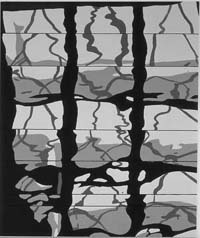Eva-Maria Wilde, Nikos Navridis
dal 19/1/2006 al 24/2/2006
Segnalato da
19/1/2006
Eva-Maria Wilde, Nikos Navridis
Magnus Muller, Berlin
Eva-Maria Wilde's paintings focus formally on the reproduction of the lucent surface, the external view of a house. They show an anonymous, faceless portrait of placeless accommodation and office towers. Nikos Navridis' video installations broach the issue of the element air, especially respiratory air, referring to the human body. Respiration is an essential part of existence: by inhalation and exhalation the rhythm of life is characterised and human life is preserved.

Two Exhibitions
In her third show in gallery magnus muller, Eva-Maria Wilde presents works
from the years 2005 and 2006, created especially for this purpose.
After
having constructed mainly spatial and colourful installations, Eva-Maria
Wilde is now more engaged in paintings. Beside two large-sized paintings, 30
small paintings made of acrylic, lacquer and gouache on MDF or canvas in the
colour spectrum of black, white and grey will be shown at Magnus muller.
Wilde's city views focus on the urban space of mega cities, their facades,
structures and constructions. During her trips through Asia¹s boom towns,
the artist has produced an extensive picture archive which she uses as
inspiration and sample. The main motive in her paintings is the external
view of accommodation and office towers and their reflection in the glass
facades. Thus the architectural fragments get the structure of water
surfaces in which light reflections are broken. Due to the selected details
an intense abstraction of a whole architectural structure is generated an
impression which is intensified by the emphasis on the surface. Often the
image is dissolved into a raster-like pattern of a horizontal and vertical
grid. The motives are as fragmentary as the perception of human beings in
metropolis which also can handle only a small part of visual impressions.
Eva-Maria Wilde's paintings focus formally on the reproduction of the lucent
surface, the external view of a house. They show an anonymous, faceless
portrait of placeless accommodation and office towers. Nevertheless, Wilde
has developed her own imagery language in which the commutability of modern
architecture gets their own aesthetics. The interior of a building, the
life, is perceptible through the observation of the facade, even if it is
not shown in visual terms, and the invisible is experienced through the
visible.
Nikos Navridis is one of the most well known contemporary Greek artists.
magnus muller presents film stills from the video installation The Question
of the Age of the Void (1996/2005) and the video projection Breath (2005),
which has already been shown at the 51st Venice Biennial.
Navridis' video installations broach the issue of the element air,
especially respiratory air, referring to the human body. Respiration is an
essential part of existence: by inhalation and exhalation the rhythm of life
is characterised and human life is preserved. Nikos Navridis studies the
materialisation and visualisation of the invisible element air through the
human being. His artistic means are similarly light and ephemeral as the air
itself - and similarly vulnerable as the human body: gum serves as a
substitute for skin and balloons become containers in which extension and
concentration of air are visible and perceptible.
In the video installation The Question of the Age of the Void Navridis shows
the dense of the empty room. Two twin sisters blow up a balloon by using
mouth pieces at each of the ends. The size of the balloon gets larger and
larger until the video screen is almost filled and the women are placed out
of the visible part of the image. The size of the balloon gradually
diminuishes, the women¹s faces appear again on the right and left side and
press to the centre, as if their mouths wanted to touch themselves in the
centre and through the gum. The inhalation and exhalation process
characterise the blowing up in common of the balloon - his creation so
that the whole process becomes an act of communication.
Nikos Navridis is interested in both ancient and contemporary theatre. In
the video projection Breath (2005), which has already been shown at the 51st
Venice Biennial, he refers to Samuel Beckett¹s homonymous theatre piece from
1969. Beckett¹s one minute piece shows a stage loaded with rubbish without
protagonists. It starts with a slight sobbing from afar which becomes the
sound of the inhalation and ends again with a sobbing in the distance.
In
Beckett's piece one can find all the essential elements which are important
to Navridis: the inhalation as a metaphor of the birth and the exhalation as
a metaphor of death. In Breath Navridis focuses on the image of the rubbish
by projecting pictures of rubbish on the gallery wall. The viewer moves
directly through this picturesque projection which underlies a permanent
repetition. In Breath Navridis talks about the fugitiveness of life and the
human tragedy, but he does this with easiness and a lot of optimism. Breath
thus becomes the expression of the pole of tension of human existence.
Opening: January 20
Magnus Muller
Weydingerstr. 10/12 - Berlin
Hours: tue-sat 12-6pm



